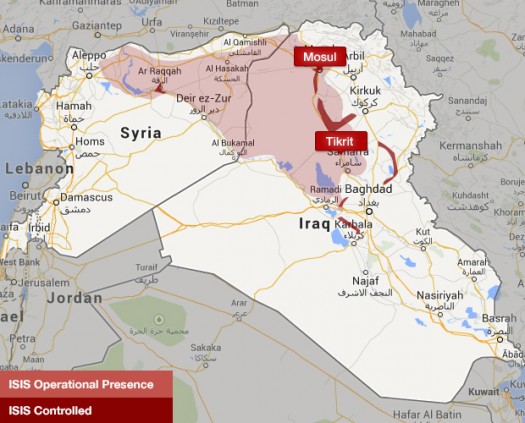 The U.S. military and two Arab allies on Wednesday bombarded a dozen small-scale oil refineries in eastern Syria as part of an expanding campaign to cut off key sources of financing and fuel for the Islamic State, according to the Pentagon.
The U.S. military and two Arab allies on Wednesday bombarded a dozen small-scale oil refineries in eastern Syria as part of an expanding campaign to cut off key sources of financing and fuel for the Islamic State, according to the Pentagon.
U.S. fighter jets and drones, alongside warplanes from Saudi Arabia and the United Arab Emirates, struck the refineries in remote parts of the Syrian desert one day after a larger wave of airstrikes targeted Islamic State training sites, ammunition depots and command centers in the country, U.S. military officials said. Wednesday’s operation was part of a broader strategy to sever supply lines and transportation corridors connecting Islamic State strongholds in Syria and Iraq, the officials said.
The Islamic State is estimated to produce between 25,000 and 40,000 barrels of oil a day, earning as much as $1 million a day, according to industry experts.
The attacks on the refineries came on a day when U.S. military forces reported hitting an Islamic State convoy in Syria near the Iraqi border and Syrian opposition groups reported heavy bombardment in areas near Turkey. American planes also carried out five airstrikes in Iraq, U.S. officials said.
Islamic State fighters are waging a two-front war in Iraq and Syria, seeking to expand the boundaries of their self-declared caliphate, or state ruled by strict Islamic law. The group is accused of widespread atrocities in both countries and the beheadings of at least three Western hostages.
Despite broad resentment of the Islamic State in Syria, the expansion of strikes against the extremist group has been met with mixed reactions. After more than three years of war, Syrian residents and rebels have expressed frustration that the intervention is not targeting President Bashar al-Assad’s government. Some held small-scale demonstrations Wednesday against the coalition strikes.
Eight Islamic State vehicles were hit in an airstrike northwest of the border town of al-Qaim, U.S. Central Command said. Syrian opposition activists said the coalition strikes occurred near Boukamal, where the Islamic State drove out other rebels in July after seizing the al-Qaim border crossing. Islamic State bases and checkpoints were also targeted later in the day, the Britain-based Syrian Observatory for Human Rights said.
The organization also said several aerial attacks were carried out near Kobane, a town on the border with Turkey that has been the site of intense battles in recent weeks between Islamic State fighters and militias from Syria’s Kurdish region. It was unclear who carried out those reported airstrikes. U.S. military officials did not report launching attacks in the area near the Turkish border.
Moustafa Oniedi, a Kurdish activist in Marj Ismael, about two miles from Kobane, said that there were strikes south of Kobane but that they did not hit active fronts with Islamic State militants. Still, in an area where the radical fighters’ offensive has displaced tens of thousands of people, the intervention was met with enthusiasm.
“The strikes triggered a lot of joy,” Oniedi said. “People were clapping, chanting and dancing in celebration because the Americans are hitting the region and they believe that the U.S. came to their rescue.”
More than 130,000 refugees fled to Turkey to escape the battles before Turkish authorities closed the border. Hundreds more refugees fled Wednesday.
Elsewhere, there were small-scale protests. A video purporting to be from Kafr Nabl in Idlib province, an area not controlled by Islamic State militants and known for its liberal anti-government stance, showed a small group of demonstrators taking to the streets.
In another scene from the town, captured in a photo, activists held up a sign reading “Americans! If you don’t topple al-
Assad now, don’t boast about democracy.”
 The message reflects the sentiments of many in the Syrian opposition who see Assad, not the Islamic State, as the main enemy.
The message reflects the sentiments of many in the Syrian opposition who see Assad, not the Islamic State, as the main enemy.
Another video posted on social media from the Idlib town of Kafr Tkharam showed a small crowd chanting, “The people want the Islamic State!” and “Down with the Western-Arab coalition!” — a reference to the United States’ allies in the military campaign.
“Of course, the Syrian [Opposition] Coalition has welcomed the international coalition to join us in our fight against extremism,” said Monzer Akbik, a member of the Syrian political opposition group. “There should be advancement on the ground by the Free Syrian Army to liberate those areas.”
Further muddying the picture are the U.S. strikes against the Khorasan group, which is embedded with Jabhat al-Nusra, an al-Qaeda-linked group that has popular support in Syria. About 50 Jabhat al-Nusra fighters were killed in a strike on Tuesday, rebels said.
Jabhat al-Nusra was pulling out of its bases Wednesday, said Ali Bakran, a rebel commander with a brigade linked to the relatively moderate Free Syrian Army. He moved to Turkey from Idlib after the airstrikes began.
“People are so angry,” he said. “For a long time they have been caught between the Islamic State and the regime. Now they are caught between the Islamic State, the regime and the United States and their coalition’s strikes.”
In Iraq, Islamic State fighters have been pushed out of some towns but have managed to make gains against Iraqi forces in other areas, despite a U.S. bombing campaign that began Aug. 8. The extremist group said in a statement Wednesday that it killed about 300 soldiers Sunday in an attack on an Iraqi army camp in the western province of Anbar.
Washington Post
Leave a Reply
You must be logged in to post a comment.